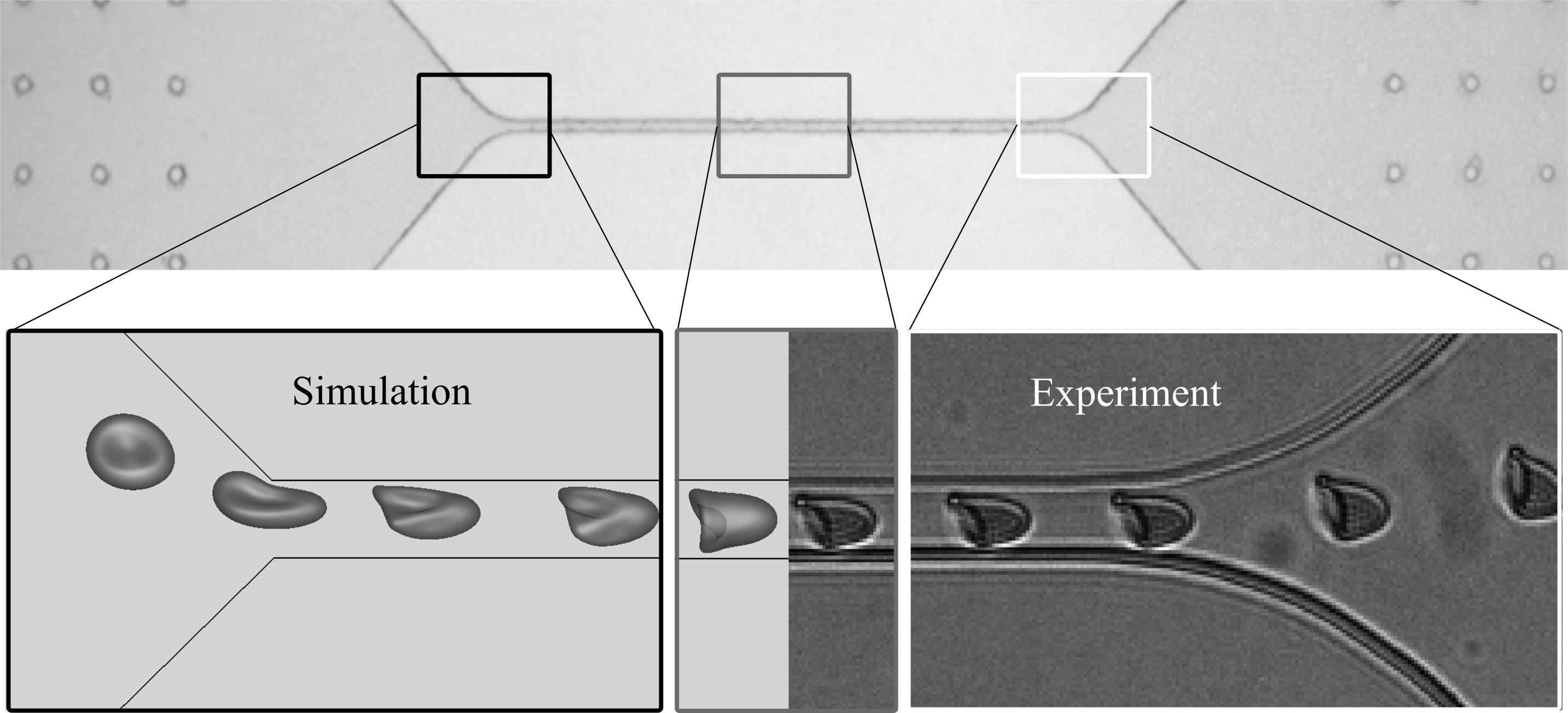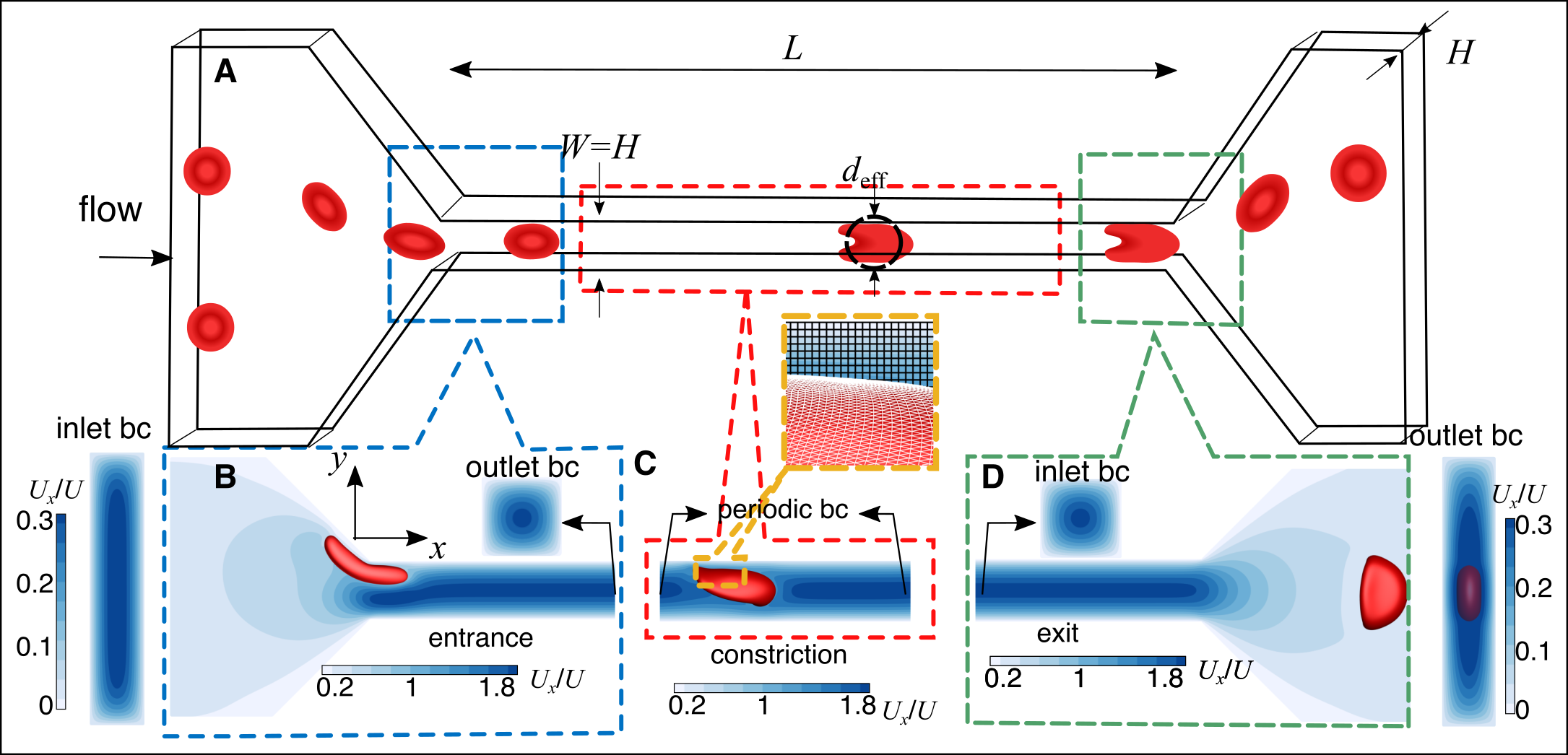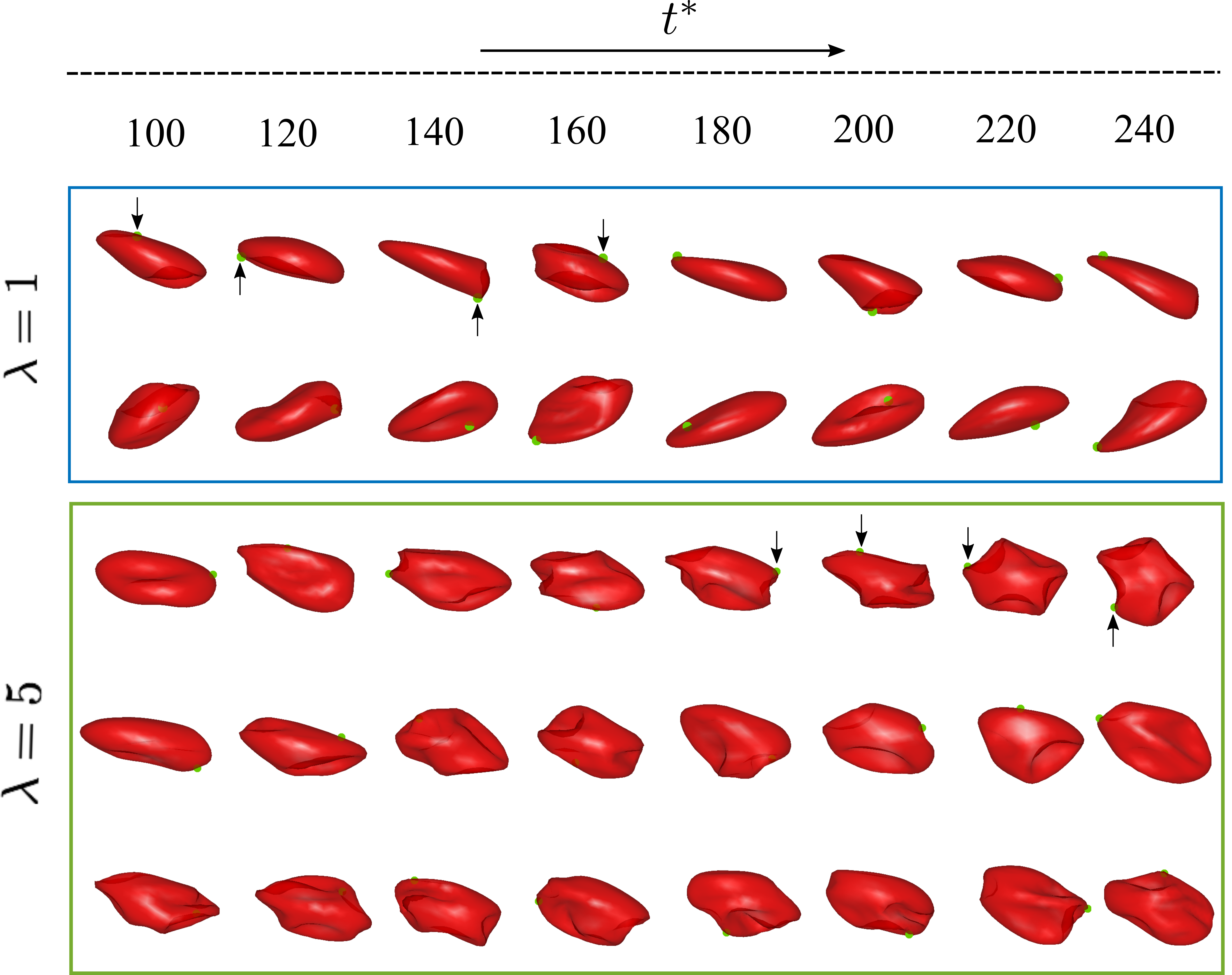Research highlights
High-throughput Measurement of Red Blood Cell (RBC) Biomechanics
Reduced deformability of red blood cells (RBCs) can affect the hemodynamics of microcirculation and reduce oxygen transport efficiency. It is also well known that reduced RBC deformability is a signature of various physical disorders, including sepsis, and that the primary determinant of RBC deformability is the membrane shear modulus. To measure the distribution of an individual’s RBC shear modulus, we have a) developed a high-fidelity computational model of RBCs in confined microchannels to inform design decisions and b) fabricated a novel microfluidic flow, imaging, and image-analysis system. We first applied our computational simulation platform to construct the appropriate deformability figure(s) of merit to quantify RBC stiffness based on an experimentally measured, steady cell shape in flow through a microchannel.
 |
Main steps towards evaluating the RBC deformability alteration in pathological conditions. |
In particular, we determined a shape parameter based on the second moment of cell shape that is sensitive to the changes in the membrane stiffness and cell size. We then conducted microfluidic experiments and developed automatic image processing codes to track individual RBCs within the micro-constrictions. For this purpose, we fabricated microchannels with square cross-sections (7x7 μm2) and applied a small gauge pressure (10 kPa) at the inlet to induce cell movement ( 10 mm s-1). Using this device, we have measured, for the first time, thousands of RBC shear moduli in a number of healthy individuals as well as demonstrated the changes in the distribution with aging of a given sample. This microfluidic device and supporting computational tools are intended to diagnose blood cell disorders in patients relative to healthy controls.
 |
A micro-channel for measuring RBC velocity and shape to determine membrane elastic resistance. |
Link to videos:
The simulations were conducted to evaluate the impact of initial condition, and to find the steady-state shape, respectively. We utilized the steady-state shapes to generate a surface for data interpretation relating the three important non-dimensional parameters: the Taylor deformation, the confinement, and the capillary number (based on cell velocity).
 |
Simulation domains, boundary conditions, and mesh resolution. |
Collective Dynamics of Red Blood Cells in Micro-vasculature
I studied the effect of RBC deformability and cytoplasmic viscosity on its migration and distribution in small-medium arterioles (20-35 μm). In particular, we addressed the following aims:
The effect of RBC deformability on its distribution and clear fluid layer in small arterioles,
The impact of cytoplasmic viscosity on cell shapes, migration, and clear fluid layer.
Cell deformability alters in certain pathologies and cytoplasmic viscosity is mostly determined by hemoglobin concentration. Under normal conditions, a red blood cell has an internal viscosity 5-6 times higher compared to the viscosity of the plasma. It was found that the distribution of RBCs in smaller arterioles are subjected to a qualitatively different behavior compared to medium sized arterioles. I also found that the cytoplasmic viscosity significantly reduces the RBC-free layer, changes the concentration distribution of the cells normal to the walls, and slows down the formation of RBC accumulation at the center of the channel. The simulations indicated the formation of rich configurational diversity among the cells, from simple slipper-liked to trilobe and multilobe shapes which have been observed experimentally. Interestingly, the single cell hydrodynamic lift is significantly affected for higher viscosity contrast, whereas two cell collision remains almost unaffected.
 |
Simulation of RBC suspension at 10-20% hematocrit (volume percent) at physiological viscosity ratio. |
Link to videos:
Transport of Architecturally Complex Macromolecules in Dilute and Semi-dilute Polymeric Solutions
 |
Three distinct projects that have been done using BDpack, semi-dilute polymers and single comb DNA molecules under extensional flow and tethered DNA under shear flow. |
I have developed a simulation platform BDpack on the basis of Brownian dynamics to do high fidelity prediction of both transient and steady-state properties of semi-dilute polymer solutions while including full long range hydrodynamic interactions (HI) and excluded volume effects. The simulation platform is used to study the transport of interacting multiple chains under equilibrium condition and also in shear and planar elongational flow. I used this platform to study the dynamics of comb polymers in dilute solutions, and the simulation results revealed the significant impact of branches on the unraveling stretching dynamics and also relaxation behavior of comb polymers with respect to the linear chains. Currently, I am continuing the project by investigating the dynamic behavior of architecturally complex macromolecules, in particular comb polymers, in a bath of semi-dilute chains. In addition to this topic, I am working with one of graduate students in our group who studies the dynamics of nanoparticles with multiple tethered polymers using Brownian Dynamics (BD) simulations and BDpack.
Microstructure-Rheology Relationship of Complex Fluids
 |
TEM image of ABS-nanoclay composites. The steady-state and oscillatory viscosity measurement, and stress relaxation of nano-composites. |
I have worked with a bevy of rheological measurements to characterize polymer melts with complex microstructure, such as acrylonitrile‐butadiene‐styrene (ABS) and also ABS, PS, and other polymeric nano-composites which are filled with spherical or non-spherical nano particles. I have conducted stress relaxation, nonlinear stress overshoot, creep test, etc. I have also utilized other optical characterizations such as XRD and TEM.